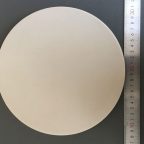The damage of the ceramic plate is mainly caused by the unstable propagation of cracks. The action of the tool tip during machining will leave a certain degree of sharp machining marks on the machined surface, resulting in small crack defects and stress concentration, reducing The fatigue strength of structural ceramic parts affects the electrical and magnetic properties of functional ceramic plates. Therefore, ultra-precision machining of ceramic plates must be carried out to reduce small crack defects and stress concentration, and to improve the fatigue strength of parts.
Usually, the high-precision machining that reaches or exceeds the accuracy limit of this era is called ceramic ultra-precision machining. In the 1980s, the machining technology with a machining accuracy of 0.05um was called ultra-precision machining; by 2000, the ultra-precision machining accuracy can be up to Inm or less. Ultra-precision machining technology is an emerging comprehensive new machining technology. It integrates advanced technological achievements such as modern machinery, optics, computers, measurement and materials, so that the precision of ultra-precision machining has been improved from the micron level in the 1960s to the current nanometer level, which greatly improves the performance and reliability of products. Ultra-precision machining methods mainly include ultra-precision cutting, ultra-precision grinding, and ultra-precision grinding.
Ultra-precision cutting is mainly a cutting method with high-precision machine tools and single crystal diamond tools. Ultra-precision cutting can be used to process photosensitive drums, magnetic disks, magnetic drums, and high-power mirrors. As well as small and medium-sized ultra-precision parts such as plane, spherical or multi-faceted prisms.
Ultra-precision grinding is carried out by using the cutting edge of the abrasive grains distributed on the surface of the grinding wheel to cut the workpiece. Since the grinding T tool grinding wheel is cut with many tiny cutting edges of abrasive, the amount of cutting removed is also extremely small, so the machining accuracy is high. However, since grinding is the action between the surface tool and the workpiece, the grinding resistance produced by it is several times or even a hundred times larger than that of the single-edged tool. In order to obtain high grinding accuracy, high rigidity grinding wheels and grinding machines are necessary.
Ceramic polishing is the mechanical friction between the free abrasive particles and the machining fluid between the workpiece and the grinding tool, or the micro-cutting of the material under the action of mechanical, chemical and other physical phenomena, so that the workpiece can meet the requirements. The machining method to achieve the geometric size and surface roughness (≤0.1um) accuracy. The polishing process must be carried out on the basis of the completion of the grinding process. It requires the use of fine abrasives, a polishing disc with uniform and fine structure, a polishing liquid that can disperse the abrasive, and the polishing disc and machining fixtures require that the dust be washed in distilled water and ultrapure water. Also have a dust-free environment. It is mainly suitable for the machining requirements of high surface precision and minimal machining deterioration layer of functional ceramic material components to ensure the function of components.
The non-destructive surface polishing technology of crystalline materials is a method of micro-removal of materials without destroying the crystal structure of the extremely surface layer. According to the state of machining, damage-free polishing can be regarded as carried out by mechanical action and chemical action. In order to ensure the performance of electronic and optical components made of various functional ceramic materials, a series of mirror ultra-precision polishing methods have been developed without machining metamorphic layers and without surface damage (without disturbing the atomic arrangement of crystals). In addition, new technologies such as chemical polishing, electrochemical polishing, ultrasonic vibration polishing and oil stone polishing of semiconductor materials have appeared.
Pintejin machining ceramic service include : Alumina Ceramic Parts, Zirconia Ceramic, Silicon Carbide Ceramic, CNC Machined Aluminum Nitride Ceramic, Machinable Ceramic Parts, Glass Ceramic,Macor Ceramic,Powder Metallurgy Dies,Ceramic Injection Molding,Ceramic Dry Pressing,Ceramic Extrusion Dies




